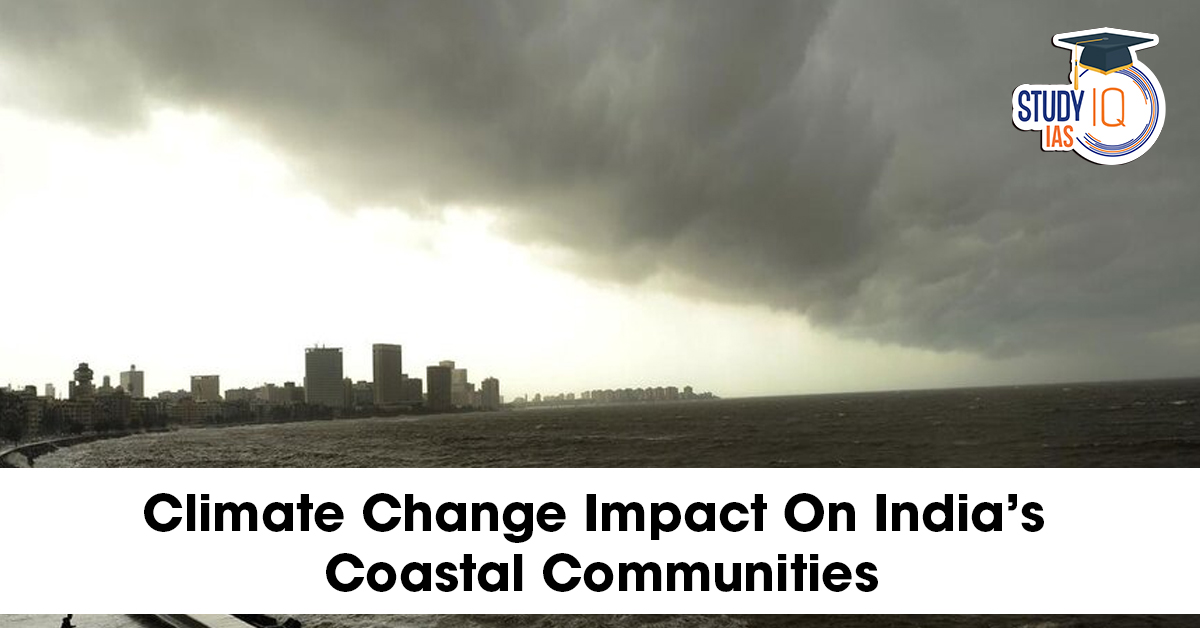Table of Contents
Context: Climate change is affecting India’s coastal communities with a deep social and economic impact.
How Climate Change is Impacting Coastal Communities in India
Environmental Impacts
- Sea Level Rise: Swallowing villages (e.g., Satabhaya in Odisha), flooding, permanent land loss.
- Saltwater Intrusion: Contaminates soil and freshwater, reducing agricultural productivity.
- Ecosystem Degradation: Loss of mangroves, wetlands, and sand dunes reduces natural coastal protection.
- Extreme Weather Events: Increased cyclones, storms, and flooding cause recurrent displacement.
Socio-economic and Livelihood Impacts
- Displacement: Thousands forced to migrate as homes and livelihoods disappear.
- Loss of Traditional Livelihoods: Agriculture and fishing become unviable due to degraded resources.
- Urban Migration: Displaced families enter precarious, informal urban labour markets.
- Community Disintegration: Social networks and cultural identities are eroded.
Key Challenges Faced by Coastal Communities
Livelihood Insecurity
- Loss of Traditional Livelihoods: Coastal communities have long depended on fishing, farming, and related activities. Rising sea levels and saltwater intrusion have destroyed fertile farmland and fishing zones.
- Example: In Satabhaya, Odisha, seawater has engulfed villages and ruined both fields and ponds, forcing families to abandon farming and fishing.
- Urban Migration and Job Insecurity: Displaced families often migrate to cities, but lack marketable skills and documentation, ending up in informal, unstable jobs such as construction labour, domestic work, or brick kilns.
- Example: Fisherfolk from Honnavar, Karnataka, or Nagapattinam, Tamil Nadu, are now seen working as daily wage labourers in Bengaluru and Chennai.
Legal and Policy Gaps
- No Legal Recognition for Climate Migrants: Existing frameworks such as the Disaster Management Act, 2005, the Environment (Protection) Act, 1986, and the Coastal Regulation Zone (CRZ) Notifications, including the diluted CRZ 2019, are limited either to disaster response or environmental conservation, without adequately factoring in the socio-economic dimensions of displacement.
- Eg., CRZ 2019 prioritises commercial interests over community rights.
- Lack of Socio-Economic Safeguards: No legal guarantees for decent work, housing, education, or healthcare for climate migrants.
- Labour Codes (such as the Building and Other Construction Workers’ (Regulation of Employment and Conditions of Service) Act, 1996) do not extend specific protections to climate-displaced workers.
- Weak Rehabilitation: Resettlement colonies lack basic amenities and sustainable livelihood options.
- Weak Enforcement of Environmental Justice: Supreme Court judgments (like M.C. Mehta vs. Union of India) recognise environmental rights, but there’s no robust framework to translate this into practical protection for climate migrants.
Environmental Injustice
- Lack of Community Consent: Large-scale development projects often proceed without the genuine, informed consent of local communities, despite legal requirements.
- Example: Fishing communities in Gujarat’s Kutch region have protested loss of access to traditional fishing grounds to port and industrial development, but with limited impact.
- Suppression of Environmental Defenders: Grassroots protests (like the Ennore Creek movement in Tamil Nadu or Pattuvam in Kerala) face police intimidation, legal harassment, and criminal charges, discouraging community activism.
What Can Be Done
- Legal and Policy Reforms: Explicitly define and protect climate-induced migrants in law and policy.
- Extend workplace protections, social security, and rights to climate migrants.
- Prioritize ecological sustainability and community rights over commercial development.
- Livelihood and Social Security: Offer new skill programs tailored for displaced coastal populations.
- Guarantee access to housing, health, education, and work for migrants in cities.
- Strengthen public distribution, insurance, and welfare schemes for at-risk families.
- Participatory and Community-Led Adaptation: Involve communities in coastal zone management and resettlement planning.
- Protect and restore mangroves, wetlands, and sand dunes as natural barriers.
- Protect environmental defenders and promote local, sustainable alternatives.
- Climate-Resilient Infrastructure: Design resettlement colonies with climate resilience in mind.


 Bonnet Macaques: Habitat, Features, Beha...
Bonnet Macaques: Habitat, Features, Beha...
 Periyar Tiger Reserve, Map, Flora, Fauna...
Periyar Tiger Reserve, Map, Flora, Fauna...
 Project Cheetah in India, Objectives, Ch...
Project Cheetah in India, Objectives, Ch...

























